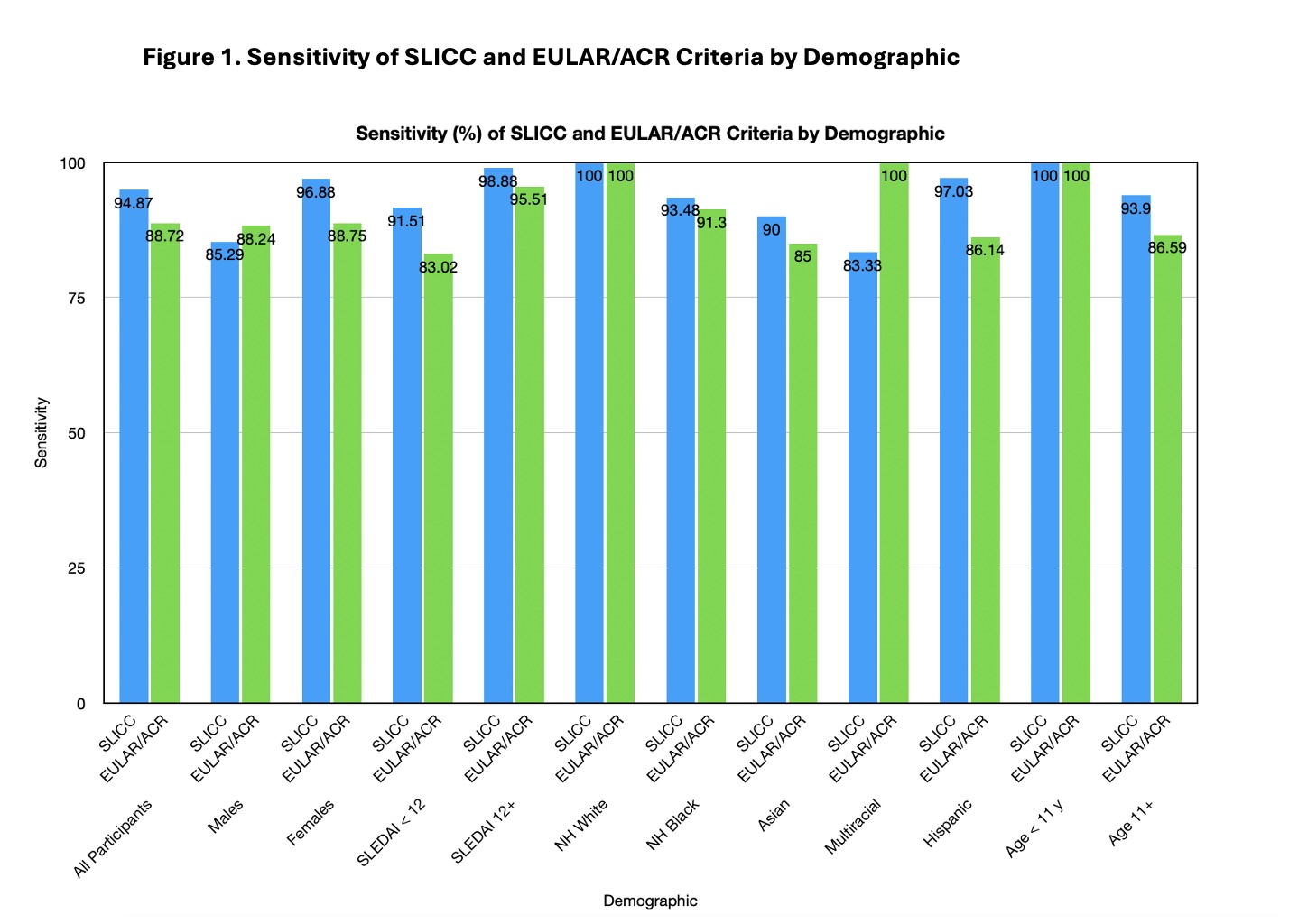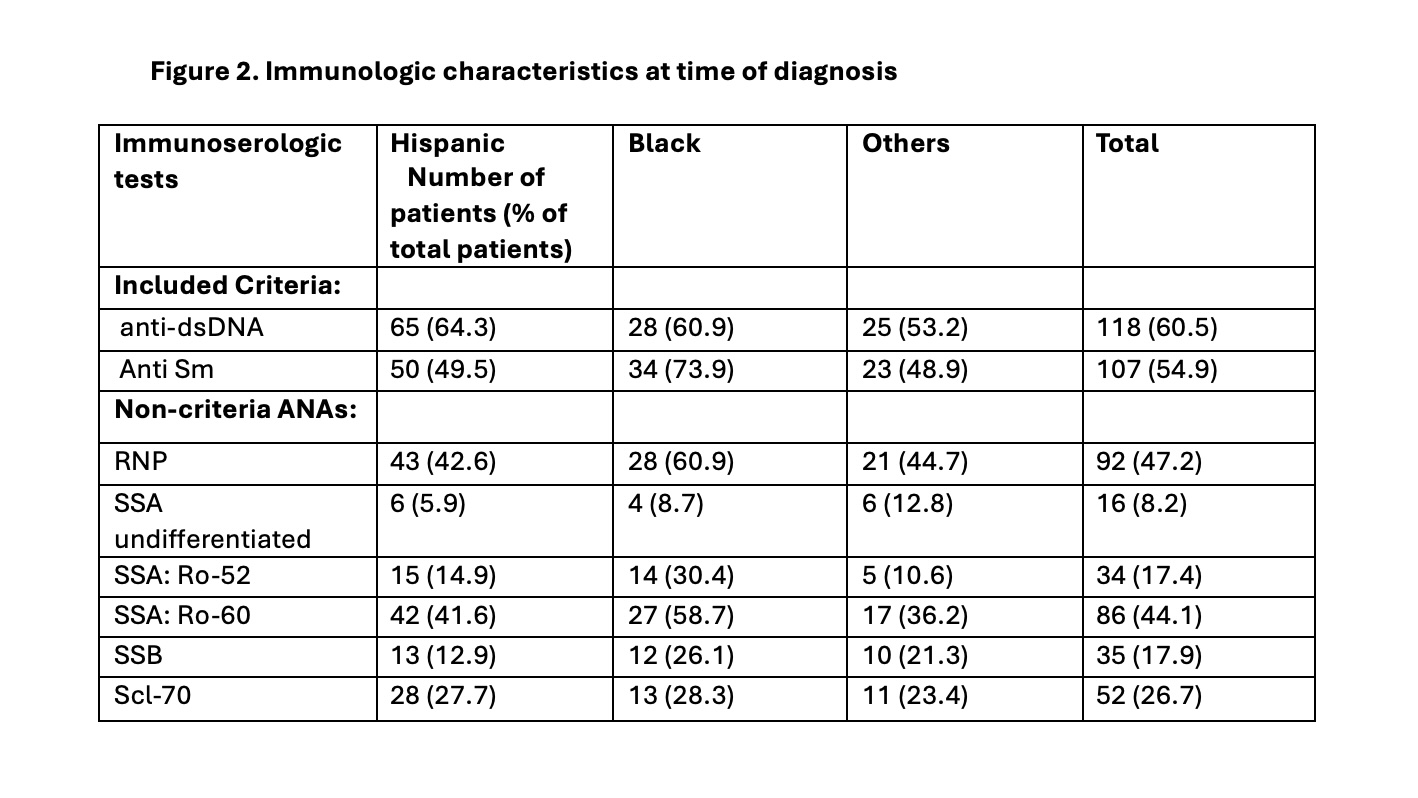Session Information
Session Type: Poster Session A
Session Time: 10:30AM-12:30PM
Background/Purpose: Systemic Lupus Erythematosus (SLE) is a systemic autoimmune disorder with diverse features, posing classification challenges. In 2019, EULAR and ACR developed new classification criteria to identify SLE clinical trial candidates earlier in the course of their disease. This criteria gives weighted scores to symptoms and disease biomarkers, such as antibodies and complement levels and has been shown to be more sensitive and specific for adult SLE. This criteria has not been validated in a large multiracial study of juvenile SLE yet. We assessed the sensitivity of the EULAR/ACR criteria as compared to the 2012 SLICC criteria for patients with jSLE. Non-criteria clinical and immunologic features were reviewed. Disease manifestations and scores were analyzed in relation to patient self-reported race and ethnicity.
Methods: We completed an IRB-approved, retrospective chart review of newly diagnosed jSLE patients at Texas Children’s Hospital from January 2018 through December 2023. Data included demographics and clinical and immunologic findings at time of diagnosis. Summary statistics and sensitivity analysis for the EULAR/ACR and SLICC criteria were performed in Stata v 18.1 (StataCorp, College Station, TX, USA).
Results: Among 195 new jSLE patients, the majority identified as Hispanic (n=101, 51.8%) or non-Hispanic (NH) Black (n=46, 23.6%). Most were female (n=160, 82.1%) and 84.1% were 11 years or older at time of diagnosis (age range: 3.6-19.4). In our cohort, SLICC sensitivity exceeded EULAR/ACR sensitivity (94.87% vs. 88.72%, respectively). Although EULAR/ACR performed better for patients with higher SLEDAI scores, it did not match the sensitivity of SLICC criteria (Figure 1). NH White patients demonstrated 100% sensitivity with both scores despite presenting with lower SLEDAI scores. SLICC showed 10.89% higher sensitivity than EULAR/ACR for Hispanic patients. Arthritis and cutaneous manifestations (including rash and/or alopecia) were significantly associated with EULAR/ACR positivity. 50-60% of patients in each race/ethnicity group had arthritis. Hematologic findings were observed in 75-89.1% of patients in each group, which was significantly associated with SLICC positivity but not EULAR/ACR. Neuropsychiatric SLE symptoms were more common in NH Black and Multiracial patients, while renal involvement did not significantly differ among race and ethnicity groups. Regarding non-criteria immunologic features, Ro-60 and RNP antibodies were the most frequently positive ANA in this cohort (Figure 2).
Conclusion: This study compared SLICC and EULAR/ACR scores’ sensitivity in our cohort of SLE patients. The EULAR/ACR criteria showed better performance for NH Black patients than Hispanic patients, with SLICC demonstrating more sensitivity for both groups. Sensitivity increased with higher SLEDAI scores. A large-scale study in a multiracial and multiethnic population is needed to better compare the EULAR/ACR and SLICC criteria in jSLE.
To cite this abstract in AMA style:
Butts M, Beil E, Guffey D, Ramirez A, Yildirim-Toruner C, Peckham-Gregory E, De Guzman M. Sensitivity of 2019 EULAR/ACR SLE Criteria and Initial Organ Manifestations for Black and Hispanic Children with Juvenile Systemic Lupus Erythematosus (jSLE) at a Large Tertiary Care Center [abstract]. Arthritis Rheumatol. 2024; 76 (suppl 9). https://acrabstracts.org/abstract/sensitivity-of-2019-eular-acr-sle-criteria-and-initial-organ-manifestations-for-black-and-hispanic-children-with-juvenile-systemic-lupus-erythematosus-jsle-at-a-large-tertiary-care-center/. Accessed .« Back to ACR Convergence 2024
ACR Meeting Abstracts - https://acrabstracts.org/abstract/sensitivity-of-2019-eular-acr-sle-criteria-and-initial-organ-manifestations-for-black-and-hispanic-children-with-juvenile-systemic-lupus-erythematosus-jsle-at-a-large-tertiary-care-center/


